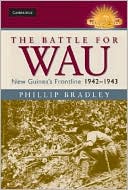|
|
|
|
| Missing In Action (MIA) | Prisoners Of War (POW) | Unexploded Ordnance (UXO) |
| Chronology | Locations | Aircraft | Ships | Submit Info | How You Can Help | Donate |
|
 by Phil Bradley Cambridge University Press 2008 Hardcover 384 pages Index, Maps, Photos ISBN: 0521896819 Cover Price: A$65.00 Language: English Order now at amazon.com Return to |
The Battle for Wau New Guinea's Frontline 1942-1943 Occasionally a book makes such a strong impression you make a mental note to read whatever the author might write. It is unusual, indeed quite remarkable when you have that reaction with the book of a first-time author. It happened to me, though with Phillip Bradley. His first book published in 2004 On Shaggy Ridge told the story of Australians in battle in a voice that was clear and authoritative, with attention to individuals and detail that was comprehensive and compelling, a story, parts of which will remain with the reader across the years. Now we have his second book. Same format, almost exactly the same length, same country, same focus on the Australians at war, but from a slightly earlier time in the New Guinea campaign, and in battle at a place that is possibly slightly less known even to Australian military history readers. You would wonder if it would work a second time, you would fear, on opening The Battle for Wau, that perhaps it was too much of a risk to try it all again. Not a bit of it. This is just as good a book as On Shaggy Ridge and it is now fair to say that in Phillip Bradley Australia has found another military historian of the very first rank. Last time, in reviewing Bradley, I started off with the old cliché about a historian needing a stout pair of boots. Recently I reviewed a book which told another story of Australians in World War II where it was abundantly clear that the writer had not for a second trod in the path of the Australians he was writing about. The deficiency showed on just about every page of that book. Bradley’s familiarity of the land over which the Australians fought around Wau is so strong, so developed, so intense that the reader can see what he has seen, can walk on the tracks that the Australians fought over, can live in the pitiless jungle that gave these men homes for months and years. He proves again and in spades that you simply cannot do military history without an absolute familiarity with the places of battle. He concentrates again on individuals in battle and has an appropriate sense of the place of character in history. I was astonished to discover Edward St John as a brave and forthright but junior leader. Yet in Bradley’s hands we find St John resolute, bold, brave and very necessary to the story. It makes you think – St John’s emergence into the story – that war shapes men that are never predictable. And may give them qualities that may never see the light of day again. Or that, more simply, we are all better in our youth than in our mature years. Yet, in truth, Ted St John is a minor character in The Battle for Wau. It is just that Bradley keeps coming up with these sorts of surprises that force his readers to think deeply about the bigger questions. And that is always what very good history should do. Other characters come and go, too, and unlike On Shaggy Ridge there is steel in Bradley’s treatment of some Australian leaders. He has no time for the first of Australians in command at Wau, Colonel Norman Fleay, and apparently with good reason. Fleay was promoted quickly from lieutenant to lieutenant-colonel, all in a matter of months, and as Bradley wisely observes, ‘while rank could be readily conferred, the experience implied by rank could not.’ Bradley writes of Fleay as ‘panic-stricken’ and criticises New Guinea command for not relieving the hapless colonel. Bradley convinces me that this is all fair, but Fleay’s treatment reminds us that war is mighty tough on reputations. You’ll meet though, plenty of men to admire and marvel at. Like Lieutenant pat Dunshea, who had left school at the age of 12 and gone on the road with his swag, looking for work: ‘a tough life had made him a tough man and taught him all about self-reliance, an invaluable quality in New Guinea’. Dunshea is described as ‘the toughest physical specimen, black or bloody white, in New Guinea’. Bradley’s eye for the detail and the right quote almost never fails him. So all the elements of good military history can be found in this book: a good and clear narrative, character aplenty, a well-developed sense of place, an agile understanding of tactical and strategic complexity, and a strong sense of the ambiguity of life and war. Thrown together with important contemporary and modern photographs and clear and frequent maps, this is truly a book to relish. Just one problem. Published by Oxford four years ago and two pages shorter, On Shaggy Ridge sold for $45. The Battle for Wau published by Cambridge in the same Australian Army History Series that has just now moved publishers, and two pages shorter, sells for $75. That is a great pity. This book deserves a wider readership than that price will allow. Review by Michael McKernan The Canberra Times May 31, 2008 Return to Book Reviews | Add a review or submit for review |
| Discussion Forum | Daily Updates | Reviews | Museums | Interviews & Oral Histories |
|